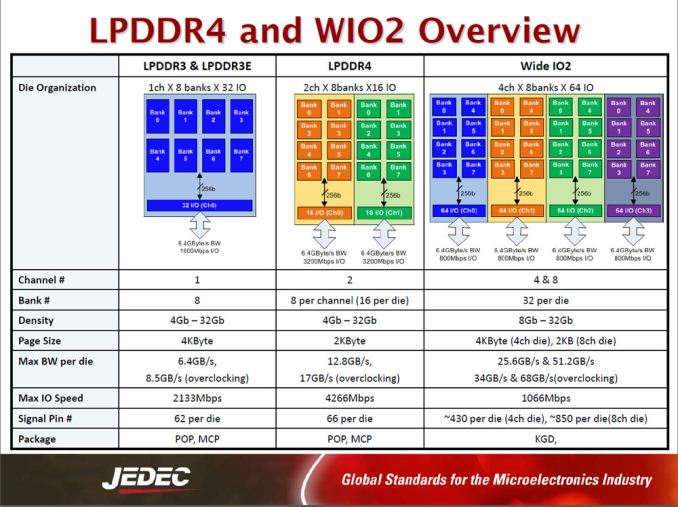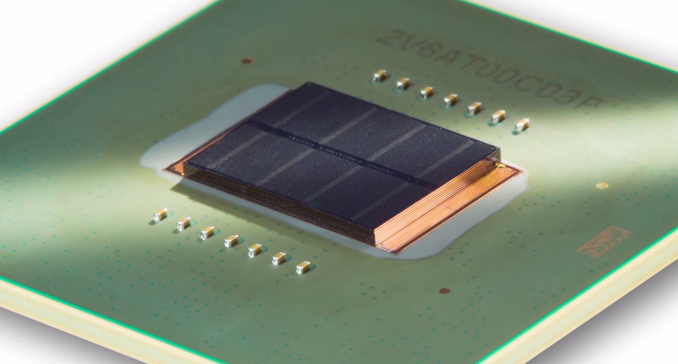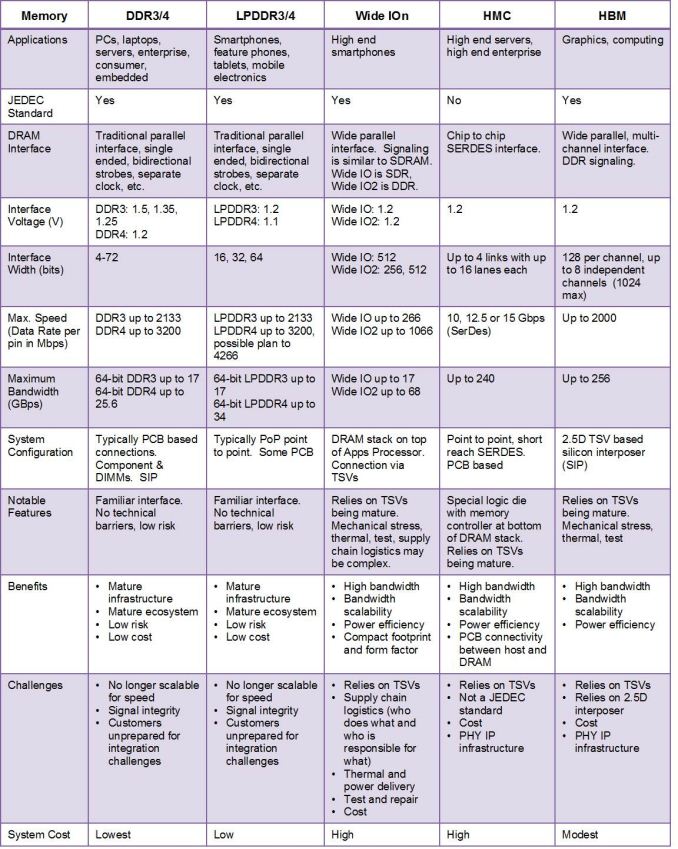DDR4 Haswell-E Scaling Review: 2133 to 3200 with G.Skill, Corsair, ADATA and Crucial
by Ian Cutress on February 5, 2015 10:10 AM ESTThe Future of DDR4
DDR4 was first launch in the enthusiast space for several reasons. On the server side, any opportunity to use lower power and drive cooling costs down is a positive, so aiming at Xeons and high-end consumer platforms was priority number one. Any of the big players in the datacenter space most likely had hardware in and running for several months before the consumer arms got hold of it. Being such a new element in the twisting dynamic of memory, the modules command a premium and the big purchasers got first pick. The downside of when that shifts to consumer where budgets are tighter and some of the intended benefits of DDR4 are not that important, such as lower power, it causes problems. When we first launched our Haswell-E piece, the cost of a 4x4GB kit of JEDEC DRAM for even a basic eight-core system was over $250, and not much has changed since. Memory companies have lower stock levels, driving up the cost, and will only make and sell more if people start buying them. At this point, Haswell-E and DDR4 is really restricted to early adopters or those with a professional requirement to go down this route.
DDR4 will start to get interesting when we see it in the mainstream consumer level. This means when regular Core i3/i5 desktops come into being, and eventually SO-DIMM variants in notebooks. The big question, as always, is when. If you believe the leaks, all arrows point towards a launch with Skylake on the Intel side, after Broadwell. Most analysts are also in this category, with the question being on how long the Broadwell platform on desktops is to last. The 14nm process node had plenty of issues, meaning that Q1 2015 is when we have started to see more Core-M (Broadwell-Y) products in notebooks and the launch of Broadwell-U, aiming at the AIO and mini-PC (such as the NUC and BRIX) market as well as laptops. This staggered launch would suggest that Broadwell on desktops should be due in the next few months, but there is no official indication as to when Skylake will hit the market, and in what form first. As always, Intel does not comment on unreleased product when asked.
On the AMD side of the equation, despite talks of a Kaveri refresh popping up in our forums and discussions about Carrizo focusing only on the sub-45W market with Excavator cores, we look to the talk surrounding Zen, K12 and everything that points to AMD’s architecture refresh with Jim Keller at the helm sometime around 2016. In a recent round table talk, Jim Keller described Zen as scaling from tablet to desktop but also probing servers. One would hope (as well as predict and imagine) that AMD is aiming for DDR4 with the platform. It makes sense to approach the memory subsystem of the new architecture from this angle, although for any official confirmation we might have to wait a few months at the earliest when AMD start releasing more information.
When DDR4 comes to desktop we will start to see a shift in the proportions of the market share that both DDR4 and DDR3 will get. The bulk memory market for desktop designs and mini-PCs will be a key demographic which will shift more to an equal DDR3-DDR4 stage and we can hope to achieve price parity before then. If we are to see mainstream DDR4 adoption, the bulk markets have to be interested in the performance of the platforms that require DDR4 specifically but also remain price competitive. It essentially means that companies like G.Skill that rely on DRAM sales for the bulk of their revenue have to make predictions on the performance of platforms like Skylake in order to tell their investors how quick DDR4 will take the market. It could be the difference between 10% and 33% adoption by the end of 2015.
One of the questions that sometimes appears with DDR4 is ‘what about DDR5?’. It looks like there are no plans to consider a DDR5 version ever for a number of reasons.
Firstly, but perhaps minor, is the nature of the DRAM interface. It relies on a parallel connection and if other standards are indicative of direction, it should probably be upgraded to a serial connection, similarly as how PCI/PCI Express and PATA/SATA has evolved in order to increase throughput while at the same time decreasing pin counts and being easier to design for the same bandwidth.
Secondly, and more importantly, are the other memory standards currently being explored in the research labs. Rather than attempt to copy verbatim a piece from ExtremeTech, I’ll summarize it here. The three standards of interest, whilst mostly mobile focused, are:
Wide I/O 2: Designed to be placed on top of processors directly, abusing a larger number of I/O pins by TSVs, keeping frequencies down in order to reduce heat generation. This has benefits in industries where space is at a premium, saving some PCB area in exchange for processor Z-height.
Hybrid Memory Cube (HMC): Similar to current monolithic DRAM dies but using a stacked slice over a logic base, allowing for much higher density and much higher bandwidth within a single module. This also increases energy efficiency, but introduces higher cost and requires higher power consumption per module.
High Bandwidth Memory (HBM): This is almost a combination of the two above, specifically aimed more at graphics by offering multiple DRAM dies stacked on or near the memory controller to increase density and bandwidth. It is more described as a specialized implementation of Wide I/O 2, but should afford up to a 256GB/s bandwidth on a 128-bit bus with 4-8 stacks on a single interface.
Image from ExtremeTech
Moving some of the memory power consumption onto the processor directly has thermal issues to consider, which means that memory bandwidth/cost might be improved at the expense of operating frequencies. Adding packages onto the processor also introduces a heavy element of cost, which might leave these specialist technologies to the super-early adopters to begin with.
Given the time from DDR4 being considered to it actually entering the desktop market, we can safely say that DDR4 will become the standard memory option over the next four years, just as DDR3 is right now. Beyond DDR4 is harder to predict, and depends on how Intel/AMD want to approach a solution that offers higher memory bandwidth, depending at what cost. Both companies will be looking at how their integrated graphics are performing, as that will ultimately be the best beneficiary to the design. AMD has some leverage in the discrete GPU space and will be able to transfer any knowledge used over to the CPU side, but Intel has a big wallet. Both Intel and AMD has experimented with eDRAM/SRAM as extra level caches with Crystal Well and PS4/XBone, which puts less stress on the external memory demands when it comes to processor graphics, which leads me to the prediction that DDR4 will be here in the market longer than DDR3 or DDR2.
If any of the major CPU/SoC manufacturers want to invest heavily in Wide I/O 2, HBM or HMC, we will have to wait. If it changes what we see on the desktop, the mini-PC or the laptop, we might have to wait even longer.













120 Comments
View All Comments
menting - Friday, February 6, 2015 - link
simulation software, pattern recognition, anything that does a lot of data analysis and/or data transformation. Heck, whatever an SSD's BW is good for, high BW memory can also be good forretrospooty - Sunday, February 8, 2015 - link
Simulation and pat rec maybe, not that anyone uses it other than rare outliers... But Anything an SSD is good for? No, not at all. An SSD improves launch times for anything and everything from browsers to office apps, to graphic suite apps like Adobe CS to games. Everything that normal people do. HB ram improves almost zero for the vast majority of what people actually do with computers. Even what enthusiasts do.menting - Monday, February 9, 2015 - link
"SSD improves launch times for anything and everything from browsers to office apps, to graphic suite apps like Adobe CS to games. Everything that normal people do". Exactly my point. Everything that normal people do. All that an SSD does is to provide faster storage (granted, it's non-dynamic storage, unlike DRAM) such that when a CPU can't find the data in the cache nor the DRAM, it can go to it for data. If you have enough DRAM, all these software can reside in DRAM (provided that power does not go out). Also, a smart algorithm will know what software you used before so it will keep some parts in memory so the next time you launch it it will be faster. And the speed that it can relaunch will heavily depend on DRAM BW.If you want to talk about rare outliers, people who are serious enough Adobe users or gamers who really get affected in a major way by using a SSD vs a traditional HD are rare outliers. I won't be surprised if the number of those people are on par or lower than people that use simulation software or pattern recognition software.
BTW, if memory BW doesn't make much of a difference, why do graphic cards go for GDDRx instead of plain DDRx?
retrospooty - Monday, February 9, 2015 - link
"BTW, if memory BW doesn't make much of a difference, why do graphic cards go for GDDRx instead of plain DDRx?"You are seriously clouding the issue here. With a graphics card assuming you are utilizing it with a modern 3d game or such, would benefit immensely from memory bandwidth on the card... It hardly benefits at all from system RAM bandwidth. Like everything, memory bandwidth doubling while timing/latency more than doubles doesn't improve system performance much at all. Some cases ahve it diminishing performance. This is NOT about Video RAM, its system RAM and based on the Intel CPU architecture for the past 15+ years, improving memory bandwidth at the cost of latency doesn't help much...
AGAIN, as I said in my original post - "We saw almost no improvement going from DDR400 cas2 to DDR3-1600 CAS10 now the same to DDR4 3000+ CAS [rediculous]
menting - Tuesday, February 10, 2015 - link
if you just want to talk about system RAM, the biggest blame is on software and CPU architecture, since with the exception of a few, are not optimized to take advantage of BW, only latency, even when the usage condition is ripe for doing so.retrospooty - Wednesday, February 11, 2015 - link
This is an article about system RAM. Why would anyone be talking about video RAM? Agreed, it is a CPU architecture issue, however this is the world we live in and this is the CPU architecture we have... Intel is pretty much the top of the heap.FlushedBubblyJock - Sunday, February 15, 2015 - link
Don't worry there are endless thousands of bonerheads who cannot wait to be "sporting" DDR4.For most, if they are made to think it should be faster, it is, no matter what occurs in reality.
I'd say 75% of it is how happy hyped their mental attitude is about how awesome their new bonerhead equipment is marketed to be, including any errors and rumors about what it is they actually purchased and installed, which they in many cases are not clear on.
xTRICKYxx - Thursday, February 5, 2015 - link
This would be an interesting topic to return to when DDR4 becomes mainstream with higher speeds.WaitingForNehalem - Thursday, February 5, 2015 - link
Now this is an excellent article. Thank you!ExarKun333 - Thursday, February 5, 2015 - link
AMAZING article! Been waiting for this! :)